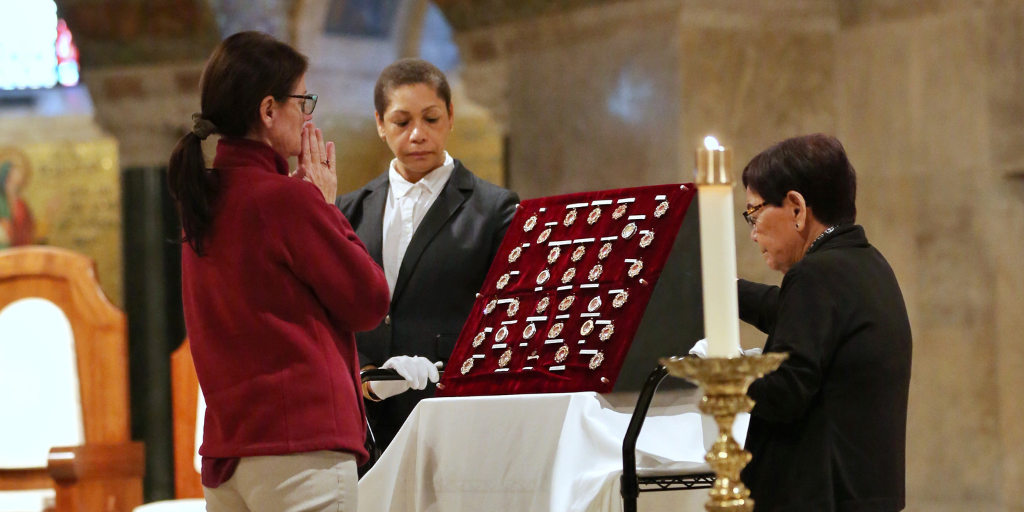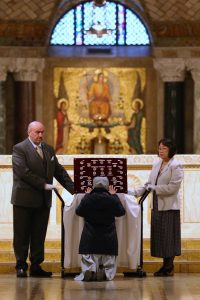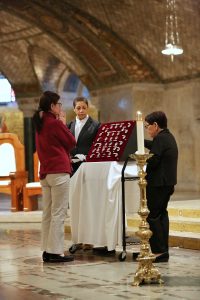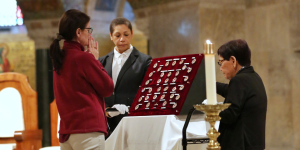
Did you know that “relic” is from the Latin root reliquiae meaning “remains” or “remnants”? As America’s Catholic Church, the Basilica is privileged to hold a treasure of Relics of the Passion of Our Lord Jesus Christ, the first and most precious relics of the Church. In the Early Church, the veneration of these relics was central to the observance of Holy Week.

The Basilica continues this tradition with the Exposition of the Relics of the Passion of Our Lord Jesus Christ. The Basilica’s collection of relics available for veneration on Good Friday includes:
- Particle of the Table of the Lord’s Supper
- Particle of stone from the Garden of Gethsemane
- Particle of the Scourging Pillar
- Particle of the purple garment worn by Jesus
- Particle from the Crown of Thorns
- Particle of stone from Golgotha (Mount Calvary)
- Particle of the seamless white tunic worn by Jesus
- Shavings of the nails or spikes, particles of the sponge and reed
- Particle of the lance which pierced the side of Jesus
- Particles of the cloths and bindings used for the burial of Jesus
- Particle of stone from the Holy Sepulchre
- Particle of the True Cross
Also displayed are relics of Mary, the Mother of Jesus, her sister, Mary, wife of Clopas, Mary of Magdala, the Twelve Apostles, and Saint Paul.
The First Relic: Particles from the Scourging Pillar
According to early Christian sources, the scourging pillar was taken to the Church of the Apostles atop Mount Sion after the destruction of Jerusalem by the Romans in A.D. 70. Today, a portion believed to be of that same pillar is housed in a chapel in one of the oldest churches in Rome, Santa Prassede (Praxedes). It was brought to the church from Constantinople in 1223. During the Middle Ages, there was such a devotion to this relic that the Holy See established a “Feast of the Holy Pillar” on the Fourth Sunday in Lent. The iron hoop, to which it is believed Jesus was tied, was donated to King Louis IX of France in 1240 in exchange for three spines from the Crown of Thorns.

The Second Relic: The Crown of Thorns
Although the crown of thorns is often depicted as a circular band or wreath, it was most likely a type of cap covering the entire head, a theory that is supported by the studies of the Shroud of Turin. In the early days of the National Shrine, Bishop Shahan had received a reliquary that contained spines from the crown of thorns. Unfortunately, the reliquary is gone, but its contents have been maintained at the National Shrine.
The Third Relic: The Lance
John is the only evangelist to include the detail: “one of the soldiers pierced His side with a spear, and immediately blood and water came out” (19: 34).
Tradition tells us that the lance was discovered inside the Holy Sepulchre along with other relics. Nothing was written about this relic until the mid-6th century, when the pilgrim Antoninus of Piacenza recorded in his pilgrimage diary that he saw “in the Basilica of Mount Sion [in Jerusalem] … the lance with which [Jesus] was struck in the side.”
Since 1492, the complete lance has been under the dome of Saint Peter’s in one of the four piers facing the main altar, guarded by Bernini’s sculpture of (Saint) Longinus, opposite the pier with the relic of the True Cross.
Plan Your Visit
The Exposition will take place in the Crypt Church of the Basilica on Good Friday, March 29, from 7:00 a.m. to 6:00 p.m., except during the noon hour, at which time the faithful will participate in Stations of the Cross.
Exposition of the Relics of the Passion of Our Lord Jesus Christ is free and open to the public – no tickets or reservations are required. Please join us in observing Holy Week through the veneration of these holy relics.

